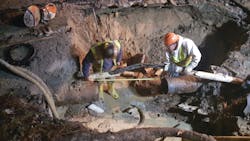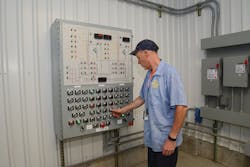A crime-fighting tactic that helps utilities draw efficiency from operations
By Bruce Duff
Nearly two decades ago, Malcolm Gladwell wrote “The Tipping Point,” a book illustrating, in part, how making small outward changes can have an enormous impact. Gladwell conveyed this through examples such as New York City’s effort in the 1980s and 1990s to markedly reduce violent crime by fighting seemingly minor wrongdoing like catching people jumping subway turnstiles.
According to Gladwell and the officials in New York whom he interviewed, violent criminals live a life of crime; often the people committing petty crimes (like jumping turnstiles) were also violent criminals with arrest warrants, carrying stolen weapons and illegal drugs. Prosecuting crimes that appeared to not be worth the effort led to apprehending serious criminals and a major upswing in the level of safety and crime prevention across the city.
The director of one of America’s largest county water and sewer departments recently told me he would “join the chorus on aging infrastructure as being the overall greatest challenge for utilities.” When I asked a superintendent for a Midwest water department what he considered the industry’s number one challenge, he replied “having adequate resources to keep up with infrastructure repair and replacement.”
These are large-scale issues, and the data supports this. For example, according to the American Society of Civil Engineers, there are approximately 240,000 water main breaks each year in the United States. The American Water Works Association estimates it will take $1 trillion for the repair, upkeep and expansion of service required in the decades ahead. And a Brookings Institution report states retirements are reducing the pool of skilled workers at utilities and, in some cases, causing vacancies of up to 50 percent.
Along with these challenges, utilities also have to ensure customer satisfaction. That requires ensuring a reliable and safe water supply while keeping labor expenses in check to stay within a budget often set by local communities. In general, utilities are under pressure to do more with less. Often when managers face challenges of this magnitude, they look for a way to affect change in a big way.
For water utilities facing serious efficiency, infrastructure and employment challenges, there’s a parallel to Gladwell’s findings. A utility can, and arguably should, make its best case for large-scale infrastructure improvements. But utilities should also look to wring efficiency from processes and procedures that managers may take for granted or consider a sunk cost. For example, how could assembling crews faster reduce costs and improve customer satisfaction? What about streamlining routine tasks (e.g., hydrant, tank or valve inspections) to help a time-strapped crew do more in the same day while reducing manual and administrative steps?
Among the strategies for gaining this real-time know-how is automating crew callout and field inspections to keep the infrastructure up-to-date and enable quick response when there’s an emergency like a water main break or pump station failure.
Suffolk County Water Authority (SCWA), headquartered in Oakdale, N.Y., is an example of a water utility that automated how it deploys its staff when responding to customer emergencies. Before automating its callout process, SCWA supervisors would make calls from paper lists while juggling other duties to assemble a crew. The manual process lengthened response time for emergencies.
After putting in place an automated callout system two years ago, supervisors were able to use a few keystrokes to have the system automatically find available workers with the right skills according to workplace agreements. That automation now enables SCWA supervisors to have paperwork ready, a “mark out” called in, and be on site when crews arrive.
SCWA also used its automated callout system to contact 800 customers who were without water for several hours, which reduced its customer service workload from hours to minutes and helped customers understand and plan around the interruption. When using the callout system after business hours, SCWA Chief Executive Officer Jeffrey Szabo said the utility mobilizes crews and responds to work up to 40 minutes faster than with the prior manual process.
“With a union workforce, there are complexities to equitably managing the order in which we call out employees,” noted Casey Allen, operations superintendent for Tennessee American Water. “Our automated callout system instantly manages complex union rules, without mistakes.”
Using the reports and analytics in its automated solution, Allen and his colleagues say they have minimized grievances related to callouts. Furthermore, think of the time utilities spend on field inspections. The volume of inspections for hydrants, tanks and pump houses varies, of course. Inspecting pumps, motors and other equipment can require diagnostic testing, various measurements and, possibly, people with different disciplines.
“For field inspections as opposed to inspecting equipment in a plant, travel time becomes an issue,” said a water and sewer department director for a large Southeastern U.S. metropolitan area. “That’s one reason automating some portion of the inspections through SCADA systems can improve efficiencies, although you need to periodically verify that the SCADA system itself is working properly.”
If a utility automated its field inspections while integrating these jobs with GIS and work management systems, then a manager could reduce labor costs and time. One way to do this might be with a mobile inspection platform. Industry experts have suggested using a device (similar to what’s deployed for meter reading) to digitally gather the inspection data and populate a database, which could be part of an asset management system designed to use inspection data, in part, to schedule maintenance at an optimal time. That approach, say some managers, could apply to pumps and motors to keep them operating at the most efficient part of the pump curve. By keeping maintenance on track, pumps stay within the design characteristics best suited for the situation and ensure water is flowing efficiently and reliably.
Another way to do this is by digitizing the myriad forms and notes that workers use to catalog the state of equipment. The typical water industry worker already uses a number of tools and technologies that other industries don’t. According to the Brookings Metropolitan Policy Program, the top four items on a list of 15 tools most commonly used by water industry workers are personal computers, desktop computers, computer tablets and screwdrivers. With mobile technology already in the hands of many workers, utilities could follow SCWA and Tennessee American Water’s lead and take another automated step by providing an inspection tool offering a guided assessment. Technology like that would expedite inspections for personnel-strapped utilities, which, in turn, leads to a steady flow of reliable, safe water service.
As workers progress through their list of inspections, the mapping tools inherent to smartphones and tablets could offer managers a quick view of an inspector’s location. Information like that would keep the worker both safe and on schedule; it would also help managers automatically communicate with workers in the field and even reallocate staff if a higher priority emerged. A fully integrated, automated inspection process would help water utilities transition from reactive maintenance to a predictive maintenance approach.
A list of inspections or meter replacements and repairs that have typically taken days to complete would become an hours-long project. Utility managers and inspectors could digitally create, distribute and receive work tickets, which would spare field personnel from interacting with multiple programs, having to drive to field branches and retrieve paperwork. By automating internal workflows related to activities like field inspections, utility managers could also ensure compliance with new or revised codes on logbooks and inspection forms as well as automatically create monthly operating reports.
Unlike a form builder that simply replaces paper documents and creates documents for mobile users to fill out, a fully automated inspection tool would be an engineering tool. A mobile inspection tool such as this would handle jobs, job scheduling, maps, asset display, asset detail review, workflow management and integrate with a customer’s critical systems.
Automating these routine procedures may not rise to the top of the industry’s list of key issues, but addressing them now could yield an outsized return. And that’s the kind of impact utilities desperately need in their fight to secure adequate resources for providing a safe, efficient and reliable water system. WW
About the Author: Bruce Duff is chief executive officer at ARCOS. He leads the strategy and execution for the company’s operations. Duff has more than 30 years of experience with the global enterprise software market and industries ranging from utilities to manufacturing. He received his bachelor’s degree from the University of Connecticut and his master’s from the Thunderbird School of Global Management. Contact him at [email protected].
References
1. Joseph Kane, and Tomer, A. “Renewing the Water Workforce,” Metropolitan Policy Program Report, The Brookings Institution, June 2018.
About the Author
Bruce Duff
Bruce Duff is chief executive officer at ARCOS. He leads the strategy and execution for the company’s operations. Duff has more than 30 years of experience with the global enterprise software market and industries ranging from utilities to manufacturing. He received his bachelor’s degree from the University of Connecticut and his master’s from the Thunderbird School of Global Management. Contact him at [email protected].

